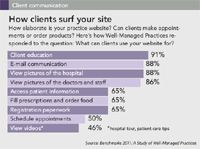How technology can enhance value for your veterinary clients
The human touch gives your practice a heart, but technology is the brain that helps you function efficiently. So kick back, relax, and let these tools do the lifting.
Technology plays a major role in nearly every part of your veterinary practice. From taking digital radiographs to performing dental procedures, cutting-edge equipment helps you offer the best care for your patients.
But while these tools help you diagnose and treat pets, who's looking out for the business side of your practice? There's always room for increased efficiency and profitability, and technology is standing by, ready to help. These days, tools like websites, social media platforms, and electronic medical records function as allies in your fight to run a successful practice. And if you haven't learned by now that these gizmos are more than just a series of circuits and switches, it's time to change your views. They're actually crucial to enhancing clients' perceptions of the value your practice offers. So let's look at how you can lean on your electronic assistants—and become a better veterinarian in the process.
In a December 2010 article published by the Harvard Business Review, researchers uncovered some of the ways that technology has changed consumer behavior. One of author David C. Edleman's findings? Consumers today can compare their current service providers to competitors more easily and more frequently. This means the idea of clients "belonging" to your veterinary practice may be a thing of the past. Pet owners are now evaluating every aspect of the service you provide, from their interaction with staff members and doctors to the appearance of your facility. And they're not just scrutinizing these things—they're posting their observations online for everyone else to see.
Kelly Baltzell, president of veterinary marketing firm Beyond Indigo Pets, says that the Internet has changed people's psychological patterns dramatically. "We now expect to find information immediately, wherever we're located. Knowledge is at our fingertips via computers and mobile devices," Baltzell says. "With the advent of the Internet, we also expect others to treat us as equals. Through the Internet and my social media networks, I am empowered as a consumer. When I purchase a service, I expect to be listened to and heard."
To keep clients coming back, you have to bond them to your practice. The tighter the relationship, the more likely people will use hospital services and pay more per visit—and that's especially true for women, Baltzell says. If clients aren't satisfied with your services and don't encourage others to visit your practice, you haven't truly engaged them. And the Internet is simply another way to engage existing and new clients, starting with your website.

Client communication
CLICK THIS WAY
In Benchmarks 2011, associates and staff members ranked a business's website as the top resource they would use to find information on that business and decide whether to visit. What's more, Well-Managed Practices say their practice website is the No. 1 most effective marketing and promotional resource they use. So what does your website say about you?
First of all, it's important to realize that your practice's website isn't a build-it-and-forget-it investment. People make decisions in one-twentieth of a second when they look at your site. Your clients are smart enough to know a good site when they see one, and it will reflect positively on your business if yours is modern and up to date.
"Clients expect a certain level of website in today's world, and I can't imagine not having a presence online. It helps start the more important personal relationship with the client because a virtual, preliminary introduction has already been made," says Dr. Thomas Burns, hospital director at Veterinary Associates of Cape Cod in South Yarmouth, Mass. "Clients are doing more homework on every important decision in the present economy, and a good website allows you to showcase your services."
Dr. Burns says the part of his practice's website his clients appreciate most is a section that helps them deal with the loss of a pet. "It's especially useful for helping children cope," he says. "I recommend that clients consult our pet loss section even before they lose a pet. You just can't give them that depth of information during painful discussions."
Dr. Burns says he also appreciates the ability to post new-client forms on the website, because clients can download and complete them before their first visit. This prevents delays on site, and the forms are often completed more thoroughly.
Managing your website can be a tedious, time-consuming process—and an investment that returns huge dividends when done well. You could delegate website maintenance to a staff member who has an interest and the technological know-how. Or consider outsourcing this responsibility. Whichever option you choose, plan on monthly or at least quarterly updates.
For guidance on how to get started, see the management tools included in Benchmarks 2011. (Information on ordering the study can be found by visiting dvm360.com/benchmarks2011. One sample tool, a guide to making your website sing your practice's praises, has been posted at dvm360.com/websitehelp.)
HOW TO MAKE FACEBOOK FRIENDS AND INFLUENCE TWEEPLE
Once you've got your website on track, it's time to tap into the power of social media. Social media is all around us—literally. According to comScore, a marketing research company, almost one in three U.S. adults owns a smartphone today. And 70 percent of smartphone owners are using some type of social media service on their phones. So social media is literally in the air—wireless bits of information whizzing around us in a frenzy of wall posts, retweets, and check-ins. This hyperconnectivity has many important implications for the veterinary industry.
First of all, it's important to recognize that the current economy has changed consumer behavior. As of right now, the economy is moving ahead slowly. More people are returning to work and resuming normal spending habits—with one important caveat. In most areas, consumers have moved away from the recessionary attitude of "I'll sacrifice what I want in order to save" to a recovery attitude of "I'll weigh the costs and benefits of my spending choices."
For that reason, it's important to show clients what your veterinary practice can offer. Social media can help accomplish this in many ways. By increasing the quality and quantity of your online content as well as creating link-backs from highly ranked sources, interaction on a social platform has a strong positive impact on your page rank. Sound like gibberish? In laymen's terms, social media activity makes Internet search engines think you're important.
A search engine is like a personal assistant. When a pet owner searches for veterinarians in his or her hometown, the search engine has to weigh a number of factors before deciding which practice website to display first. Those factors include things like importance and content. A search engine tries to determine your importance by gauging how active you are online, how much content you have on your website, how many other websites link to your site, and how many people interact with you by doing things like reviewing your practice online or writing on your Facebook wall. The more engaged you are with the online community of pet owners, the more important Google thinks you are—and the more likely it is to display your practice when someone in your area is looking for a veterinarian.

Mobile technology
Social media also offers you a way to form deeper connections with your clients. As we all know, the cost of attracting a new client is much higher than the cost of retaining an existing one. By allowing clients to interact with you online, whether that's posting on your Facebook page or following your Twitter feed, you make your practice a bigger part of their life and lower the risk they'll go elsewhere for veterinary services. (To learn more about how to use social media to market your practice and connect with clients, see "5 ways to make your door swing")
Dr. Burns says his practice focused on Facebook and Blogger as their social media platforms of choice. He and a few key managers share the responsibility. "To me, the website and our social media presence are part of overall hospital management, and they deserve personal attention," he says.

Electronic medical records
The time investment for Facebook is less than five minutes a day, he says. While blogging takes more time, Dr. Burns and his managers plan regular posts a couple times a month, and the website is updated as needed. While the practice has also dabbled in Twitter and YouTube, Dr. Burns says his strategy is to focus on a few core platforms and maintain them regularly.
Now that you understand the benefits of social media, you may be ready to implement these tools in your practice. So how do you jump on the bandwagon? Start by doing your homework. Benchmarks 2011 includes a host of management tools that will guide you through the process, including "Social media marketing: How to get started," and "7 tips to enhance client communication."
SWITCH TO ELECTRONIC MEDICAL RECORDS
Electronic medical records (EMRs) can fundamentally change the way your practice operates. No more lost charts or missed charges. No more missing information, incomplete records, or messy charts filled with bad handwriting. All of your important patient documents exist in one centralized, organized, and searchable place. The implications are huge for patient care, client convenience, invoicing, marketing, and reminders.
Dr. Burns says his practice went paperless eight years ago and has seen nothing but positive results. He says being able to access a patient's record instantly at any terminal improves efficiency. Instantaneous invoicing that's linked to medical record entries dramatically reduces missed charges. And doctors can conduct radiographic consults in a variety of locations, from the radiology room to their office. (Dr. Burns says the latter option often leads to more thorough case discussion.)
His advice for practices preparing to make the move to EMRs is to invest in a powerful computer hardware system and opt for too many workstations rather than too few. "I would strongly urge keeping your software consultant and tech support personnel on site the day before you move your records and for several days afterward to make the transition smooth. Ask them to customize the program features and settings to your practice," he says. "I would set a date and not look back. Before long you won't understand why you didn't transition sooner."
If you haven't made the change to EMRs yet, the time is ripe and the results are worth the effort. You'll be more productive while showing your clients that you're running a state-of-the-art practice.
You might feel like the speed with which technology changes makes it impossible to get on board—or that the information highway will run you over if you even try. But these tools are here to help you become a better practitioner. Whether you decide to start small or embrace technology a big way, it's ready to help put you firmly on the path to enhancing client value, strengthening relationships, and promoting your practice. All you have to do is ask.
Denise Tumblin, CPA, is a Veterinary Economics Editorial Advisory Board member and owner of Wutchiett Tumblin and Associates in Columbus, Ohio. Post comments at dvm360.com/comment.